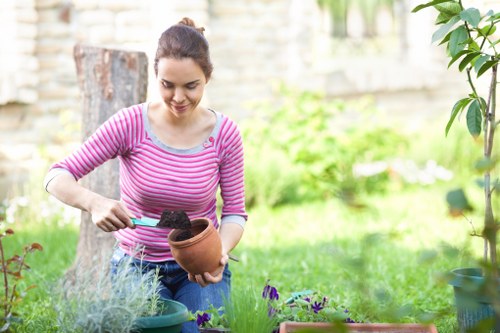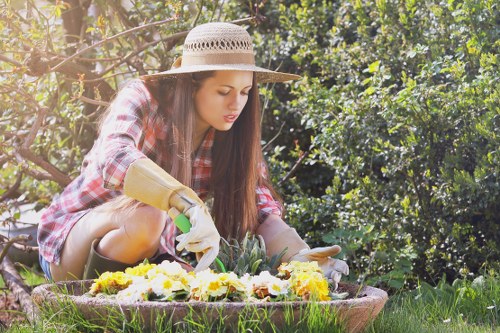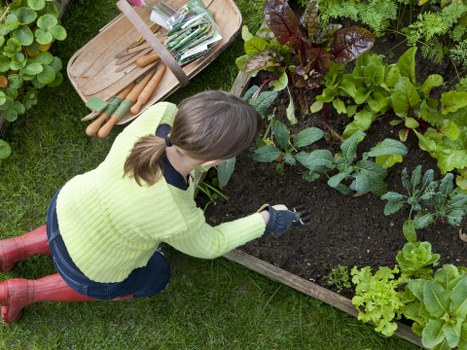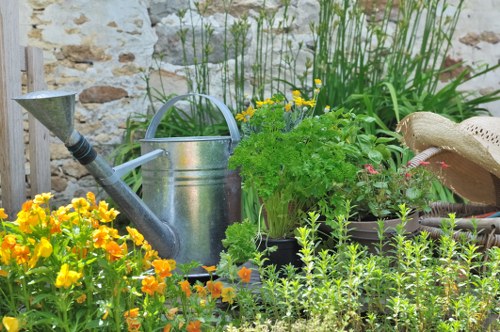Gardeners Wood Green: Your Ultimate Guide to a Thriving Garden

Welcome to the comprehensive guide for gardeners in Wood Green! Whether you're a seasoned horticulturist or just starting your gardening journey, Wood Green offers a vibrant community and a variety of resources to help your garden flourish.
Wood Green, located in North London, is renowned for its green spaces, community gardens, and a supportive network of gardening enthusiasts. The area combines urban living with access to nature, making it an ideal spot for gardeners.
In this guide, we'll explore the best gardening practices, local resources, and tips to maintain a beautiful garden in Wood Green.

Getting Started with Gardening in Wood Green
Starting a garden can be both exciting and overwhelming. Wood Green provides ample opportunities for both beginners and experienced gardeners to cultivate their green spaces.
First, assess the available space you have. Whether it's a small balcony, a backyard, or a community garden plot, Wood Green has options to suit your needs.
Next, consider the climate and soil conditions. North London's weather can be unpredictable, so choosing the right plants that thrive in your specific conditions is crucial.

Choosing the Right Plants
Selecting plants that are well-suited to Wood Green's climate is essential for garden success. Native plants are often the best choice as they are adapted to the local environment.
Consider plants like lavender, roses, and marigolds, which thrive in the temperate climate of Wood Green. These plants not only add beauty but also attract pollinators like bees and butterflies.
For those interested in growing vegetables, tomatoes, herbs, and leafy greens are excellent options that require minimal maintenance and provide fresh produce.

Essential Gardening Tools and Supplies
Having the right tools makes gardening more enjoyable and efficient. Here are some essentials every gardener in Wood Green should have:
- Hand Trowel: Ideal for planting, weeding, and transferring plants.
- Pruning Shears: Essential for trimming and shaping plants.
- Watering Can or Hose: Ensure your plants receive adequate water.
- Gloves: Protect your hands from thorns and dirt.
- Soil Tester: Helps in determining the pH levels and nutrient content of your soil.
Investing in quality tools will save you time and effort, allowing you to focus on nurturing your garden.
Local gardening stores in Wood Green offer a wide range of tools and can provide personalized advice based on your gardening needs.

Soil Preparation and Maintenance
Healthy soil is the foundation of a thriving garden. Start by testing your soil to understand its composition and pH levels. Amend the soil with compost or organic matter to improve fertility and drainage.
Regularly weeding your garden is crucial to prevent competition for nutrients. Mulching can help retain moisture and suppress weed growth, reducing the need for constant maintenance.
Consider implementing crop rotation in vegetable gardens to maintain soil health and reduce the risk of pests and diseases.
Watering Techniques for Optimal Growth
Proper watering is vital for plant health. In Wood Green's climate, it's important to water your garden consistently, especially during dry spells.
Morning is the best time to water plants, as it allows the foliage to dry throughout the day, reducing the risk of fungal diseases.
Using drip irrigation systems can help conserve water and ensure that plants receive the right amount without wastage. Additionally, rain barrels can collect rainwater, providing an eco-friendly water source for your garden.
Pest and Disease Management
Protecting your garden from pests and diseases is essential for maintaining plant health. Regularly inspect plants for signs of infestation or disease.
Introduce natural predators, such as ladybugs, to control aphids and other common pests. Organic pesticides can also be used as a safer alternative to chemical treatments.
Good garden hygiene, including removing dead plant matter and properly disposing of diseased plants, helps prevent the spread of pests and diseases.
Seasonal Gardening Tips
Each season presents unique challenges and opportunities for gardeners in Wood Green. Adapting your gardening practices to the seasons ensures year-round growth and beauty.
Spring: Begin preparing your garden by planting early vegetables and flowers. Prune shrubs and trees to encourage healthy growth.
Summer: Focus on watering, weeding, and harvesting. Protect plants from intense heat by providing shade as needed.

Autumn and Winter Care
In autumn, plant bulbs for spring blooms and start preparing your garden for the colder months. Mulch beds to protect plant roots from frost.
During winter, maintain tools and plan for the next gardening season. Consider growing hardy vegetables and using indoor containers to extend your gardening activities.
Community gardens in Wood Green often offer workshops and support during these seasons, providing valuable information on maintaining your garden year-round.
Community and Resources in Wood Green
Wood Green boasts a strong gardening community with numerous resources available to support your gardening endeavors.
The local library offers a range of gardening books and magazines, while community centers frequently host workshops and seminars on various gardening topics.
Joining local gardening clubs can provide opportunities to connect with fellow gardeners, share tips, and participate in community garden projects.

Local Nurseries and Garden Centers
Access to quality plants and supplies is essential. Wood Green is home to several nurseries and garden centers that cater to diverse gardening needs.
These establishments often carry a wide variety of plants, from exotic species to native favorites, along with fertilizers, soil amendments, and gardening tools.
Local nurseries also offer expert advice on plant care, helping you make informed decisions for your garden.
Eco-Friendly Gardening Practices
Adopting sustainable gardening practices benefits both your garden and the environment. Here are some eco-friendly tips for Wood Green gardeners:
- Composting: Turn kitchen scraps and garden waste into nutrient-rich compost to improve soil health.
- Rainwater Harvesting: Collect rainwater to reduce reliance on tap water for irrigation.
- Native Plants: Choose native species that require less water and are more resistant to local pests.
- Organic Pest Control: Use natural methods to manage pests without harmful chemicals.
- Mulching: Apply mulch to retain moisture, regulate soil temperature, and prevent weed growth.
Implementing these practices not only enhances your garden's sustainability but also contributes to the overall health of Wood Green's environment.

Urban Gardening Solutions
Urban gardening is gaining popularity in Wood Green, allowing residents to cultivate green spaces even in limited areas.
Vertical gardens, balcony planters, and container gardening are excellent options for those with restricted space. These methods maximize growing areas and add aesthetic appeal to urban settings.
Community gardens offer shared spaces where individuals can garden collectively, fostering a sense of community and shared responsibility for green spaces.
10 Nearby Areas to Explore for Gardening Enthusiasts
Wood Green is surrounded by several neighborhoods that offer unique opportunities and resources for gardeners:
- Tottenham: Just west of Wood Green, Tottenham features expansive parks and community gardens.
- Hornsey: Known for its vibrant plant nurseries and botanical stores.
- Seven Sisters: Offers a mix of residential gardens and urban green spaces.
- Finsbury Park: Home to Finsbury Park, a large park with diverse gardening areas.
- Alexandra Palace: Features areas suitable for gardening enthusiasts and nature lovers.
- Palmers Green: Known for its allotments and community gardening projects.
- Chalk Farm: Offers smaller garden spaces ideal for urban gardening.
- Highgate: Features historic gardens and green rooftops.
- Holloway: Known for its community gardens and sustainable gardening initiatives.
- Arnos Grove: Offers a variety of gardening resources and green spaces.
- Crouch End: Known for its eco-friendly gardening practices and plant diversity.
- Stroud Green: Features local nurseries and sustainable gardening workshops.
- Manor House: Offers community gardening areas and access to local parks.
- Seven Sisters: Known for cultural diversity and varied gardening styles.
- Upper Edmonton: Features community gardens and green initiatives.
Each of these areas contributes uniquely to the gardening landscape of Wood Green, providing ample opportunities for gardeners to expand their knowledge and resources.
Maintaining Your Garden in Wood Green
Consistent maintenance is key to a healthy and beautiful garden. Regular tasks such as watering, pruning, and fertilizing ensure that plants thrive.
Keep an eye out for signs of stress in plants, such as wilting or discoloration, and address issues promptly to prevent further damage.
Seasonal maintenance, including planting, harvesting, and preparing for weather changes, helps sustain your garden's vitality throughout the year.
Utilizing Local Workshops and Events
Wood Green hosts various gardening workshops and events that provide valuable learning opportunities.
Participating in these events can enhance your gardening skills, introduce you to new techniques, and connect you with other gardening enthusiasts.
Stay informed about upcoming workshops through local community boards and gardening centers.
Conclusion: Embrace Gardening in Wood Green
Gardening in Wood Green offers a fulfilling and enriching experience. With access to diverse resources, a supportive community, and ample green spaces, both novice and experienced gardeners can cultivate thriving gardens.
By following best practices, utilizing local resources, and embracing sustainable methods, you can enjoy a beautiful and productive garden year-round.
Join the gardening community in Wood Green and contribute to the vibrant green landscape that makes this area special.
Frequently Asked Questions
1. What are the best plants for beginners in Wood Green?
For beginners, plants like lavender, marigolds, tomatoes, and herbs are ideal as they are relatively easy to care for and thrive well in Wood Green's climate.
2. Where can I find community gardens in Wood Green?
Community gardens can be found in areas like Tottenham, Finsbury Park, and Palmers Green. Local community centers and the Wood Green community website provide information on joining these gardens.
3. How can I conserve water in my Wood Green garden?
Implementing drip irrigation systems, using rain barrels to collect rainwater, and mulching can significantly help in conserving water in your garden.
4. Are there local workshops for advanced gardening techniques?
Yes, Wood Green hosts various workshops on advanced gardening techniques. Check with local nurseries, community centers, and gardening clubs for schedules and enrollment information.
5. What pests are common in Wood Green gardens, and how can I manage them?
Common pests include aphids, slugs, and snails. Managing them can be done through introducing natural predators, using organic pesticides, and maintaining good garden hygiene.